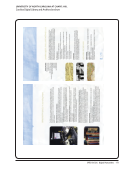SPEC Kit 326: Digital Humanities · 49
To date we have been preserving the results of production, but we have explicitly (and in writing/email) indicated that
we cannot commit to preserving all websites or online exhibits or collections assembled for more than a couple years.
We do NOT attempt to preserve “all DH project resources,” but we do have a sustainability strategy, applicable to those
we commit to preserve and those we do not.
We preserve some projects for deposit in UCIspace @the Libraries. We do not preserve the output from GIS or faculty
using available scanning or video imaging equipment. We also deposit some projects at UC system wide like Merritt.
Other
Depends on the nature of the content created.
Repository infrastructure is in developmental stage.
If yes, and your library has a strategy for ensuring the sustainability of these resources, which
strategies does your library use? Check all that apply. N=35
Work within widely accepted standards for metadata, etc. 34 97%
Preserve digital projects in repositories 29 83%
Create projects using widely supported platforms 29 83%
Develop grant proposals to support project sustainability 18 51%
Work with project planners to incorporate sustainability costs
into initial cost estimates for projects 13 37%
Audit projects for long-term sustainability 11 31%
Other strategy, please describe 5 14%
cIRcle (Institutional Repository) does preserve digital projects.
Digital initiatives support has become a core service and supported by library operating funds.
Ensure materials are created in sustainable formats or normalize to multiple formats to ensure support, retain hardware
for retro conversion as needed.
Include library’s Preservation Officer on the digital library council, which discusses and tracks library-supported digital
projects.
This question is problematic as different levels of preservation may be assigned to different resources, so “all” may not
be equally preserved. Example: not all file formats may be migrated and preserved, and a item may be deposited in
multiple formats, only one or two of which we would commit to migrating and preserving. It is a negotiated process to
determine scope of what will be preserved, not a uniform outcome.
To date we have been preserving the results of production, but we have explicitly (and in writing/email) indicated that
we cannot commit to preserving all websites or online exhibits or collections assembled for more than a couple years.
We do NOT attempt to preserve “all DH project resources,” but we do have a sustainability strategy, applicable to those
we commit to preserve and those we do not.
We preserve some projects for deposit in UCIspace @the Libraries. We do not preserve the output from GIS or faculty
using available scanning or video imaging equipment. We also deposit some projects at UC system wide like Merritt.
Other
Depends on the nature of the content created.
Repository infrastructure is in developmental stage.
If yes, and your library has a strategy for ensuring the sustainability of these resources, which
strategies does your library use? Check all that apply. N=35
Work within widely accepted standards for metadata, etc. 34 97%
Preserve digital projects in repositories 29 83%
Create projects using widely supported platforms 29 83%
Develop grant proposals to support project sustainability 18 51%
Work with project planners to incorporate sustainability costs
into initial cost estimates for projects 13 37%
Audit projects for long-term sustainability 11 31%
Other strategy, please describe 5 14%
cIRcle (Institutional Repository) does preserve digital projects.
Digital initiatives support has become a core service and supported by library operating funds.
Ensure materials are created in sustainable formats or normalize to multiple formats to ensure support, retain hardware
for retro conversion as needed.
Include library’s Preservation Officer on the digital library council, which discusses and tracks library-supported digital
projects.
This question is problematic as different levels of preservation may be assigned to different resources, so “all” may not
be equally preserved. Example: not all file formats may be migrated and preserved, and a item may be deposited in
multiple formats, only one or two of which we would commit to migrating and preserving. It is a negotiated process to
determine scope of what will be preserved, not a uniform outcome.
































































































































































































